Business Strategy of Vodafone: A Comprehensive Analysis
VerifiedAdded on 2024/05/31
|17
|4992
|360
AI Summary
This report provides a comprehensive analysis of Vodafone's business strategy, examining its external and internal environments, competitive landscape, and strategic direction. Using frameworks like PESTEL, Ansoff's Matrix, VRIO, Porter's Five Forces, and Bowman's Strategy Clock, the report delves into Vodafone's strengths, weaknesses, opportunities, and threats, highlighting its strategic capabilities and competitive positioning in the telecommunications sector. The report concludes with an interpretation of Vodafone's strategic direction and its implications for the company's future success.
Contribute Materials
Your contribution can guide someone’s learning journey. Share your
documents today.
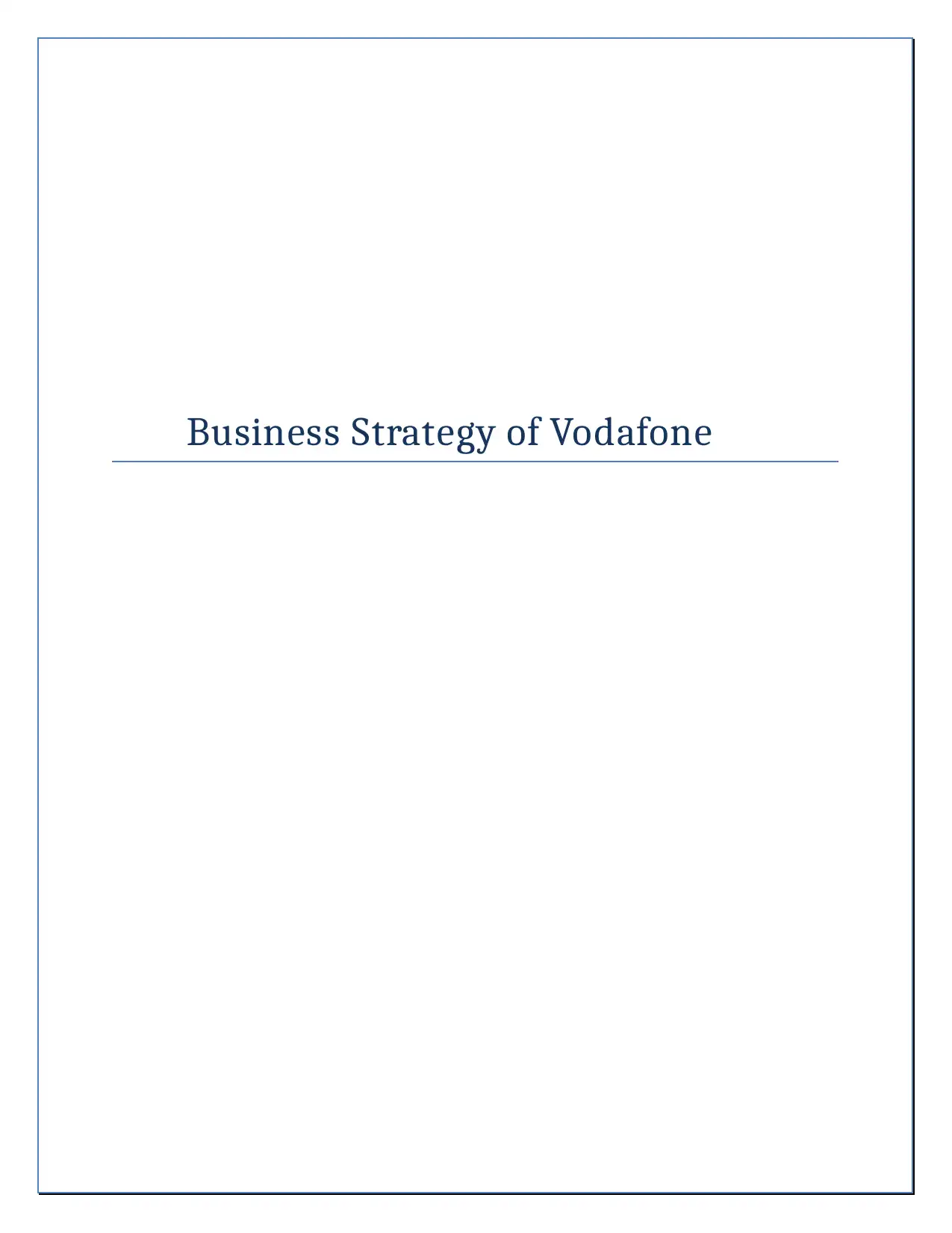
Business Strategy of Vodafone
Secure Best Marks with AI Grader
Need help grading? Try our AI Grader for instant feedback on your assignments.
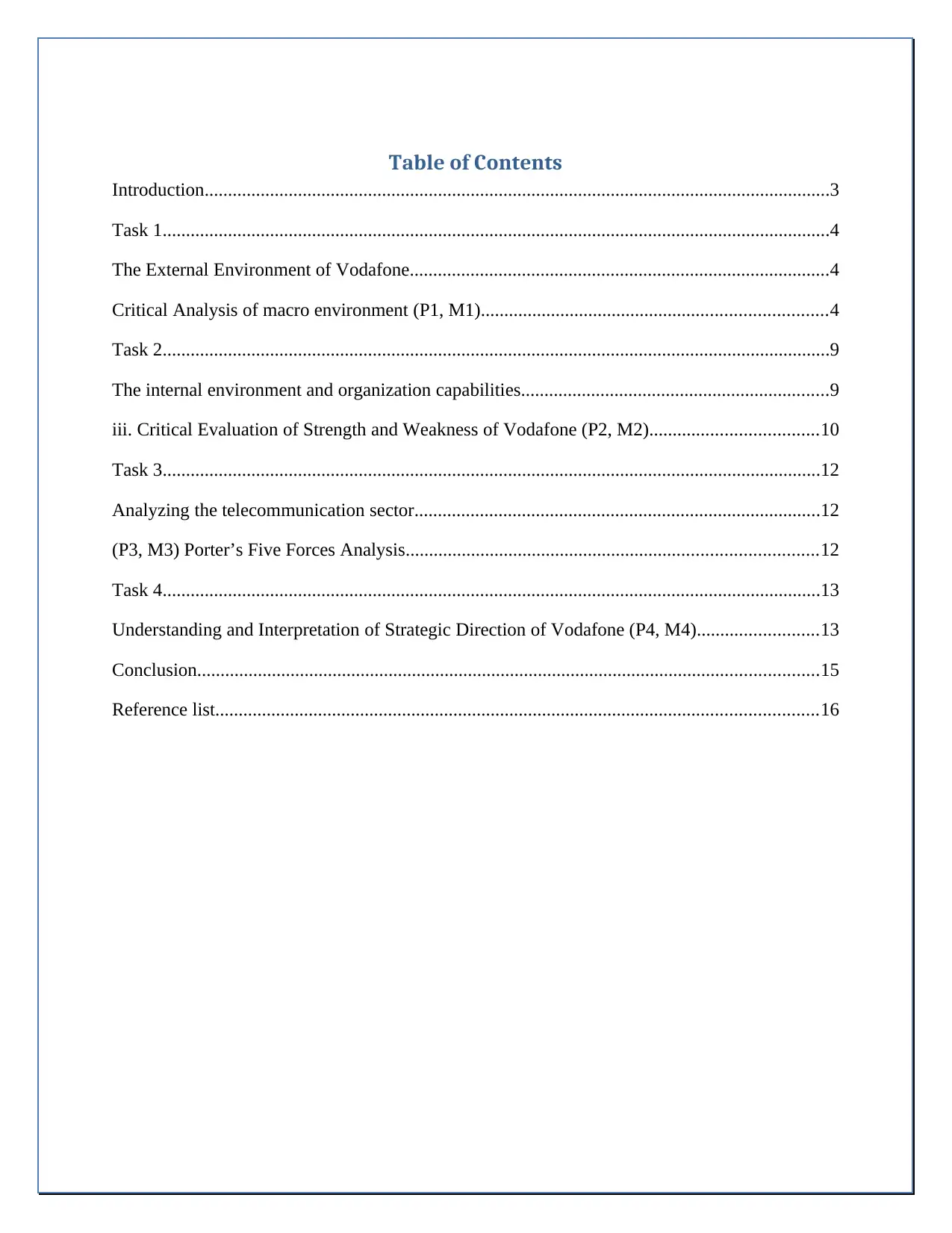
Table of Contents
Introduction......................................................................................................................................3
Task 1...............................................................................................................................................4
The External Environment of Vodafone..........................................................................................4
Critical Analysis of macro environment (P1, M1)..........................................................................4
Task 2...............................................................................................................................................9
The internal environment and organization capabilities..................................................................9
iii. Critical Evaluation of Strength and Weakness of Vodafone (P2, M2)....................................10
Task 3.............................................................................................................................................12
Analyzing the telecommunication sector.......................................................................................12
(P3, M3) Porter’s Five Forces Analysis........................................................................................12
Task 4.............................................................................................................................................13
Understanding and Interpretation of Strategic Direction of Vodafone (P4, M4)..........................13
Conclusion.....................................................................................................................................15
Reference list.................................................................................................................................16
Introduction......................................................................................................................................3
Task 1...............................................................................................................................................4
The External Environment of Vodafone..........................................................................................4
Critical Analysis of macro environment (P1, M1)..........................................................................4
Task 2...............................................................................................................................................9
The internal environment and organization capabilities..................................................................9
iii. Critical Evaluation of Strength and Weakness of Vodafone (P2, M2)....................................10
Task 3.............................................................................................................................................12
Analyzing the telecommunication sector.......................................................................................12
(P3, M3) Porter’s Five Forces Analysis........................................................................................12
Task 4.............................................................................................................................................13
Understanding and Interpretation of Strategic Direction of Vodafone (P4, M4)..........................13
Conclusion.....................................................................................................................................15
Reference list.................................................................................................................................16
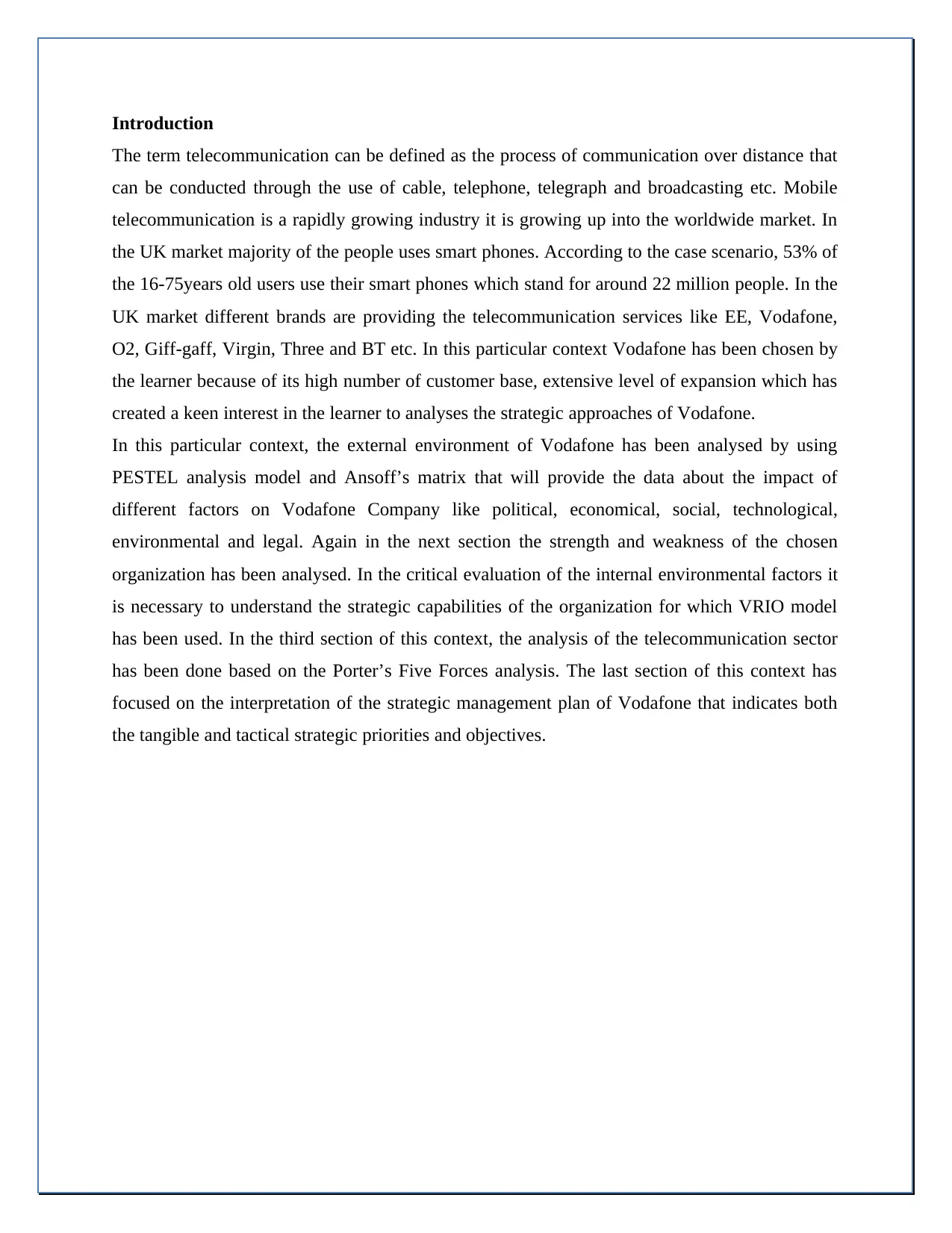
Introduction
The term telecommunication can be defined as the process of communication over distance that
can be conducted through the use of cable, telephone, telegraph and broadcasting etc. Mobile
telecommunication is a rapidly growing industry it is growing up into the worldwide market. In
the UK market majority of the people uses smart phones. According to the case scenario, 53% of
the 16-75years old users use their smart phones which stand for around 22 million people. In the
UK market different brands are providing the telecommunication services like EE, Vodafone,
O2, Giff-gaff, Virgin, Three and BT etc. In this particular context Vodafone has been chosen by
the learner because of its high number of customer base, extensive level of expansion which has
created a keen interest in the learner to analyses the strategic approaches of Vodafone.
In this particular context, the external environment of Vodafone has been analysed by using
PESTEL analysis model and Ansoff’s matrix that will provide the data about the impact of
different factors on Vodafone Company like political, economical, social, technological,
environmental and legal. Again in the next section the strength and weakness of the chosen
organization has been analysed. In the critical evaluation of the internal environmental factors it
is necessary to understand the strategic capabilities of the organization for which VRIO model
has been used. In the third section of this context, the analysis of the telecommunication sector
has been done based on the Porter’s Five Forces analysis. The last section of this context has
focused on the interpretation of the strategic management plan of Vodafone that indicates both
the tangible and tactical strategic priorities and objectives.
The term telecommunication can be defined as the process of communication over distance that
can be conducted through the use of cable, telephone, telegraph and broadcasting etc. Mobile
telecommunication is a rapidly growing industry it is growing up into the worldwide market. In
the UK market majority of the people uses smart phones. According to the case scenario, 53% of
the 16-75years old users use their smart phones which stand for around 22 million people. In the
UK market different brands are providing the telecommunication services like EE, Vodafone,
O2, Giff-gaff, Virgin, Three and BT etc. In this particular context Vodafone has been chosen by
the learner because of its high number of customer base, extensive level of expansion which has
created a keen interest in the learner to analyses the strategic approaches of Vodafone.
In this particular context, the external environment of Vodafone has been analysed by using
PESTEL analysis model and Ansoff’s matrix that will provide the data about the impact of
different factors on Vodafone Company like political, economical, social, technological,
environmental and legal. Again in the next section the strength and weakness of the chosen
organization has been analysed. In the critical evaluation of the internal environmental factors it
is necessary to understand the strategic capabilities of the organization for which VRIO model
has been used. In the third section of this context, the analysis of the telecommunication sector
has been done based on the Porter’s Five Forces analysis. The last section of this context has
focused on the interpretation of the strategic management plan of Vodafone that indicates both
the tangible and tactical strategic priorities and objectives.
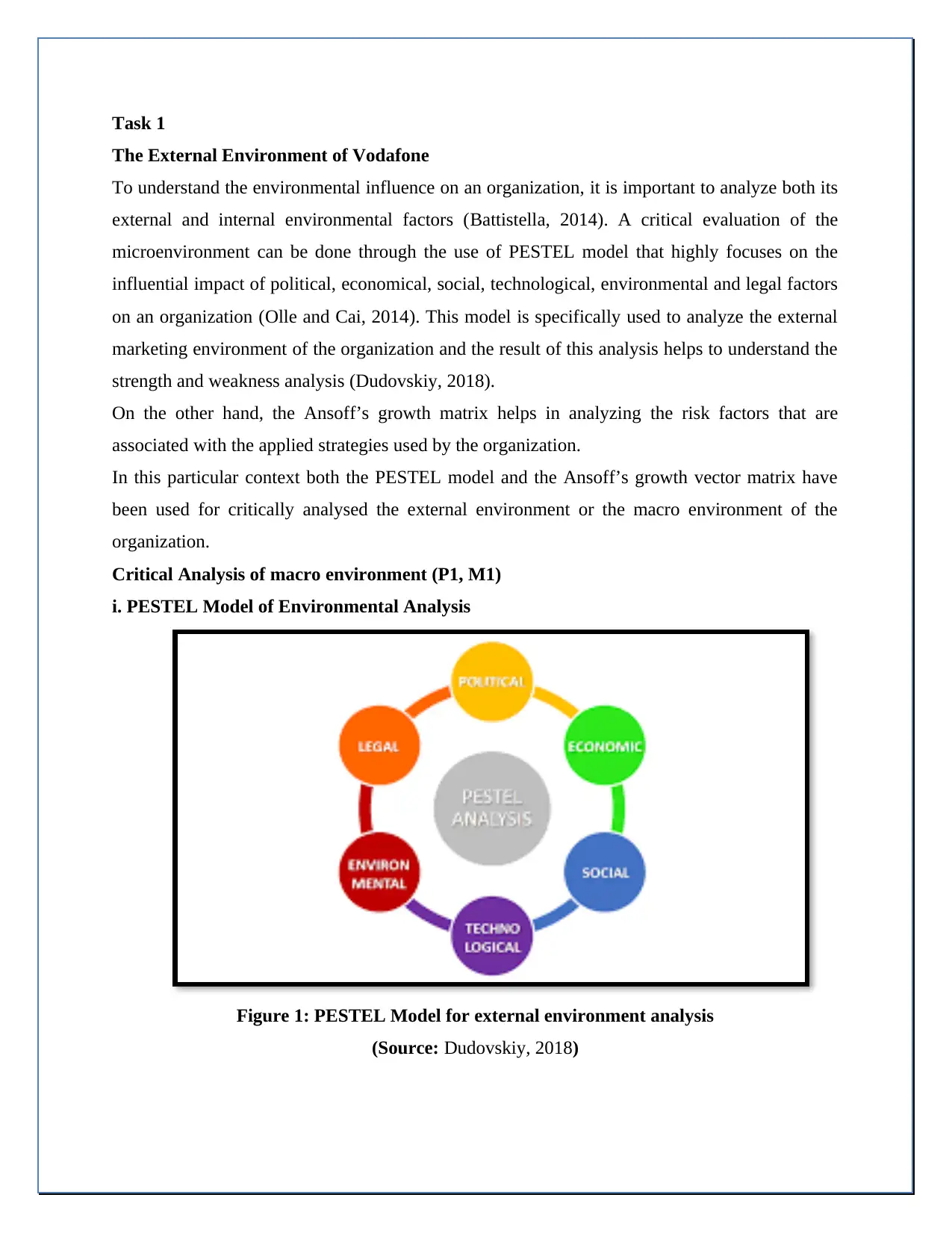
Task 1
The External Environment of Vodafone
To understand the environmental influence on an organization, it is important to analyze both its
external and internal environmental factors (Battistella, 2014). A critical evaluation of the
microenvironment can be done through the use of PESTEL model that highly focuses on the
influential impact of political, economical, social, technological, environmental and legal factors
on an organization (Olle and Cai, 2014). This model is specifically used to analyze the external
marketing environment of the organization and the result of this analysis helps to understand the
strength and weakness analysis (Dudovskiy, 2018).
On the other hand, the Ansoff’s growth matrix helps in analyzing the risk factors that are
associated with the applied strategies used by the organization.
In this particular context both the PESTEL model and the Ansoff’s growth vector matrix have
been used for critically analysed the external environment or the macro environment of the
organization.
Critical Analysis of macro environment (P1, M1)
i. PESTEL Model of Environmental Analysis
Figure 1: PESTEL Model for external environment analysis
(Source: Dudovskiy, 2018)
The External Environment of Vodafone
To understand the environmental influence on an organization, it is important to analyze both its
external and internal environmental factors (Battistella, 2014). A critical evaluation of the
microenvironment can be done through the use of PESTEL model that highly focuses on the
influential impact of political, economical, social, technological, environmental and legal factors
on an organization (Olle and Cai, 2014). This model is specifically used to analyze the external
marketing environment of the organization and the result of this analysis helps to understand the
strength and weakness analysis (Dudovskiy, 2018).
On the other hand, the Ansoff’s growth matrix helps in analyzing the risk factors that are
associated with the applied strategies used by the organization.
In this particular context both the PESTEL model and the Ansoff’s growth vector matrix have
been used for critically analysed the external environment or the macro environment of the
organization.
Critical Analysis of macro environment (P1, M1)
i. PESTEL Model of Environmental Analysis
Figure 1: PESTEL Model for external environment analysis
(Source: Dudovskiy, 2018)
Secure Best Marks with AI Grader
Need help grading? Try our AI Grader for instant feedback on your assignments.
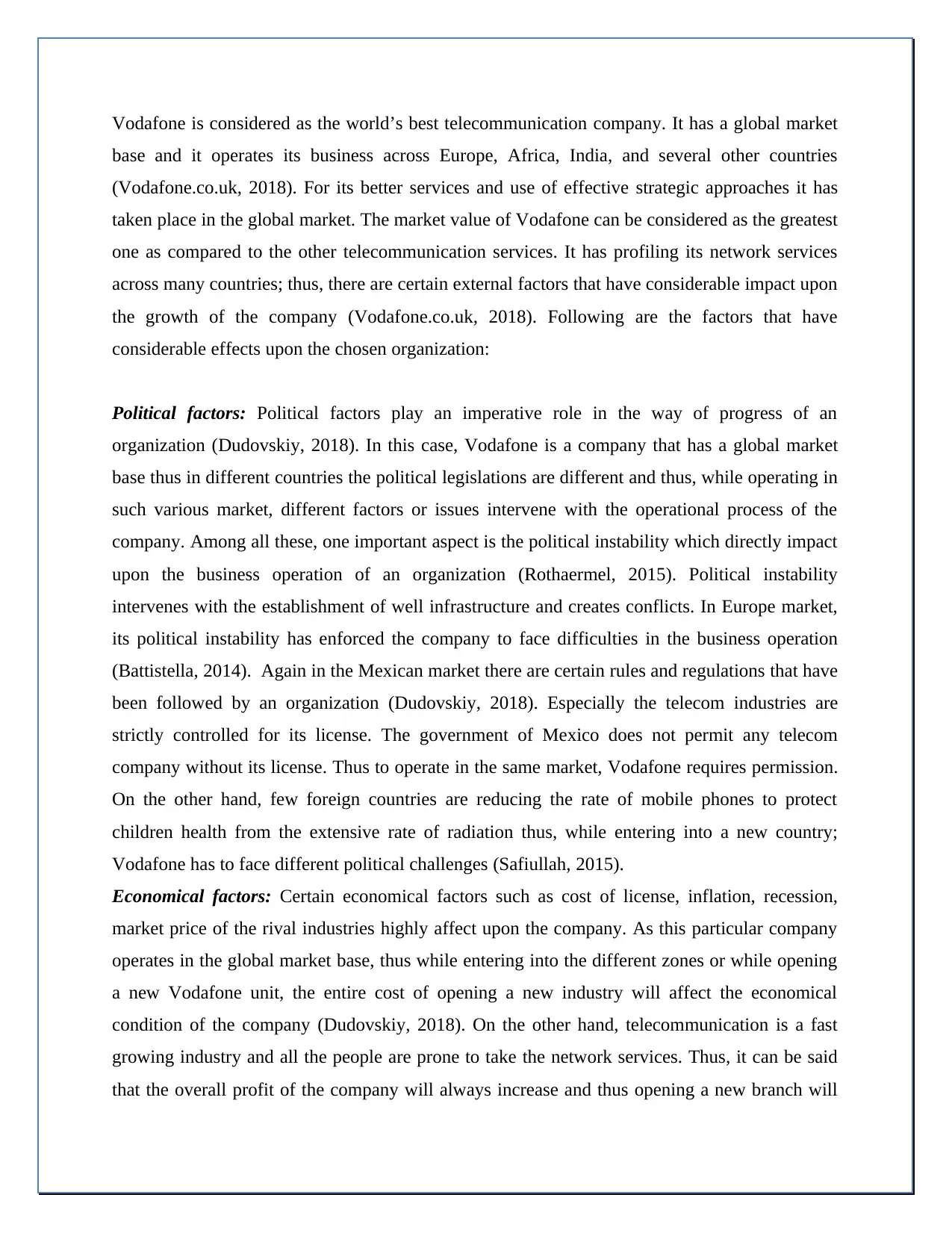
Vodafone is considered as the world’s best telecommunication company. It has a global market
base and it operates its business across Europe, Africa, India, and several other countries
(Vodafone.co.uk, 2018). For its better services and use of effective strategic approaches it has
taken place in the global market. The market value of Vodafone can be considered as the greatest
one as compared to the other telecommunication services. It has profiling its network services
across many countries; thus, there are certain external factors that have considerable impact upon
the growth of the company (Vodafone.co.uk, 2018). Following are the factors that have
considerable effects upon the chosen organization:
Political factors: Political factors play an imperative role in the way of progress of an
organization (Dudovskiy, 2018). In this case, Vodafone is a company that has a global market
base thus in different countries the political legislations are different and thus, while operating in
such various market, different factors or issues intervene with the operational process of the
company. Among all these, one important aspect is the political instability which directly impact
upon the business operation of an organization (Rothaermel, 2015). Political instability
intervenes with the establishment of well infrastructure and creates conflicts. In Europe market,
its political instability has enforced the company to face difficulties in the business operation
(Battistella, 2014). Again in the Mexican market there are certain rules and regulations that have
been followed by an organization (Dudovskiy, 2018). Especially the telecom industries are
strictly controlled for its license. The government of Mexico does not permit any telecom
company without its license. Thus to operate in the same market, Vodafone requires permission.
On the other hand, few foreign countries are reducing the rate of mobile phones to protect
children health from the extensive rate of radiation thus, while entering into a new country;
Vodafone has to face different political challenges (Safiullah, 2015).
Economical factors: Certain economical factors such as cost of license, inflation, recession,
market price of the rival industries highly affect upon the company. As this particular company
operates in the global market base, thus while entering into the different zones or while opening
a new Vodafone unit, the entire cost of opening a new industry will affect the economical
condition of the company (Dudovskiy, 2018). On the other hand, telecommunication is a fast
growing industry and all the people are prone to take the network services. Thus, it can be said
that the overall profit of the company will always increase and thus opening a new branch will
base and it operates its business across Europe, Africa, India, and several other countries
(Vodafone.co.uk, 2018). For its better services and use of effective strategic approaches it has
taken place in the global market. The market value of Vodafone can be considered as the greatest
one as compared to the other telecommunication services. It has profiling its network services
across many countries; thus, there are certain external factors that have considerable impact upon
the growth of the company (Vodafone.co.uk, 2018). Following are the factors that have
considerable effects upon the chosen organization:
Political factors: Political factors play an imperative role in the way of progress of an
organization (Dudovskiy, 2018). In this case, Vodafone is a company that has a global market
base thus in different countries the political legislations are different and thus, while operating in
such various market, different factors or issues intervene with the operational process of the
company. Among all these, one important aspect is the political instability which directly impact
upon the business operation of an organization (Rothaermel, 2015). Political instability
intervenes with the establishment of well infrastructure and creates conflicts. In Europe market,
its political instability has enforced the company to face difficulties in the business operation
(Battistella, 2014). Again in the Mexican market there are certain rules and regulations that have
been followed by an organization (Dudovskiy, 2018). Especially the telecom industries are
strictly controlled for its license. The government of Mexico does not permit any telecom
company without its license. Thus to operate in the same market, Vodafone requires permission.
On the other hand, few foreign countries are reducing the rate of mobile phones to protect
children health from the extensive rate of radiation thus, while entering into a new country;
Vodafone has to face different political challenges (Safiullah, 2015).
Economical factors: Certain economical factors such as cost of license, inflation, recession,
market price of the rival industries highly affect upon the company. As this particular company
operates in the global market base, thus while entering into the different zones or while opening
a new Vodafone unit, the entire cost of opening a new industry will affect the economical
condition of the company (Dudovskiy, 2018). On the other hand, telecommunication is a fast
growing industry and all the people are prone to take the network services. Thus, it can be said
that the overall profit of the company will always increase and thus opening a new branch will
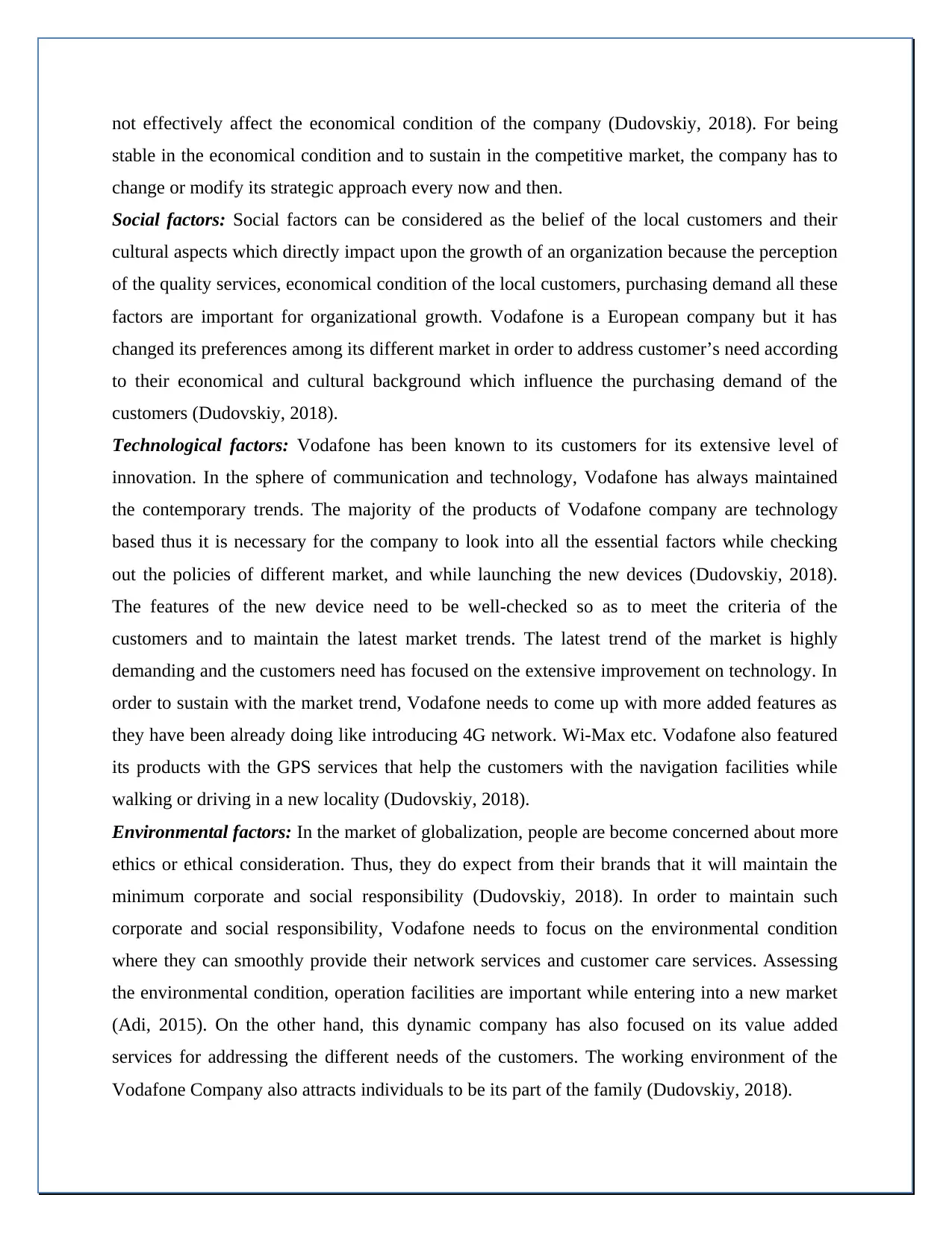
not effectively affect the economical condition of the company (Dudovskiy, 2018). For being
stable in the economical condition and to sustain in the competitive market, the company has to
change or modify its strategic approach every now and then.
Social factors: Social factors can be considered as the belief of the local customers and their
cultural aspects which directly impact upon the growth of an organization because the perception
of the quality services, economical condition of the local customers, purchasing demand all these
factors are important for organizational growth. Vodafone is a European company but it has
changed its preferences among its different market in order to address customer’s need according
to their economical and cultural background which influence the purchasing demand of the
customers (Dudovskiy, 2018).
Technological factors: Vodafone has been known to its customers for its extensive level of
innovation. In the sphere of communication and technology, Vodafone has always maintained
the contemporary trends. The majority of the products of Vodafone company are technology
based thus it is necessary for the company to look into all the essential factors while checking
out the policies of different market, and while launching the new devices (Dudovskiy, 2018).
The features of the new device need to be well-checked so as to meet the criteria of the
customers and to maintain the latest market trends. The latest trend of the market is highly
demanding and the customers need has focused on the extensive improvement on technology. In
order to sustain with the market trend, Vodafone needs to come up with more added features as
they have been already doing like introducing 4G network. Wi-Max etc. Vodafone also featured
its products with the GPS services that help the customers with the navigation facilities while
walking or driving in a new locality (Dudovskiy, 2018).
Environmental factors: In the market of globalization, people are become concerned about more
ethics or ethical consideration. Thus, they do expect from their brands that it will maintain the
minimum corporate and social responsibility (Dudovskiy, 2018). In order to maintain such
corporate and social responsibility, Vodafone needs to focus on the environmental condition
where they can smoothly provide their network services and customer care services. Assessing
the environmental condition, operation facilities are important while entering into a new market
(Adi, 2015). On the other hand, this dynamic company has also focused on its value added
services for addressing the different needs of the customers. The working environment of the
Vodafone Company also attracts individuals to be its part of the family (Dudovskiy, 2018).
stable in the economical condition and to sustain in the competitive market, the company has to
change or modify its strategic approach every now and then.
Social factors: Social factors can be considered as the belief of the local customers and their
cultural aspects which directly impact upon the growth of an organization because the perception
of the quality services, economical condition of the local customers, purchasing demand all these
factors are important for organizational growth. Vodafone is a European company but it has
changed its preferences among its different market in order to address customer’s need according
to their economical and cultural background which influence the purchasing demand of the
customers (Dudovskiy, 2018).
Technological factors: Vodafone has been known to its customers for its extensive level of
innovation. In the sphere of communication and technology, Vodafone has always maintained
the contemporary trends. The majority of the products of Vodafone company are technology
based thus it is necessary for the company to look into all the essential factors while checking
out the policies of different market, and while launching the new devices (Dudovskiy, 2018).
The features of the new device need to be well-checked so as to meet the criteria of the
customers and to maintain the latest market trends. The latest trend of the market is highly
demanding and the customers need has focused on the extensive improvement on technology. In
order to sustain with the market trend, Vodafone needs to come up with more added features as
they have been already doing like introducing 4G network. Wi-Max etc. Vodafone also featured
its products with the GPS services that help the customers with the navigation facilities while
walking or driving in a new locality (Dudovskiy, 2018).
Environmental factors: In the market of globalization, people are become concerned about more
ethics or ethical consideration. Thus, they do expect from their brands that it will maintain the
minimum corporate and social responsibility (Dudovskiy, 2018). In order to maintain such
corporate and social responsibility, Vodafone needs to focus on the environmental condition
where they can smoothly provide their network services and customer care services. Assessing
the environmental condition, operation facilities are important while entering into a new market
(Adi, 2015). On the other hand, this dynamic company has also focused on its value added
services for addressing the different needs of the customers. The working environment of the
Vodafone Company also attracts individuals to be its part of the family (Dudovskiy, 2018).
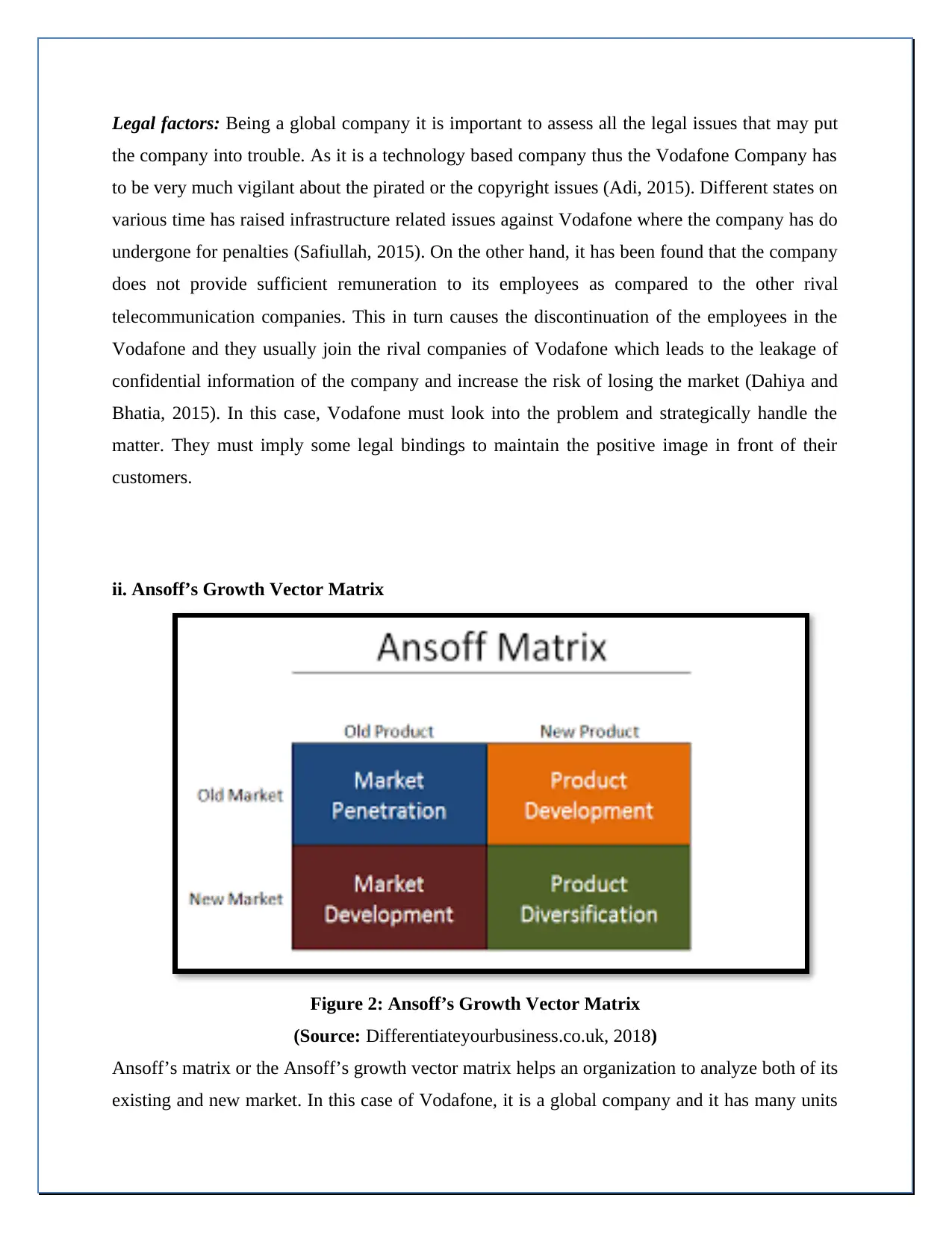
Legal factors: Being a global company it is important to assess all the legal issues that may put
the company into trouble. As it is a technology based company thus the Vodafone Company has
to be very much vigilant about the pirated or the copyright issues (Adi, 2015). Different states on
various time has raised infrastructure related issues against Vodafone where the company has do
undergone for penalties (Safiullah, 2015). On the other hand, it has been found that the company
does not provide sufficient remuneration to its employees as compared to the other rival
telecommunication companies. This in turn causes the discontinuation of the employees in the
Vodafone and they usually join the rival companies of Vodafone which leads to the leakage of
confidential information of the company and increase the risk of losing the market (Dahiya and
Bhatia, 2015). In this case, Vodafone must look into the problem and strategically handle the
matter. They must imply some legal bindings to maintain the positive image in front of their
customers.
ii. Ansoff’s Growth Vector Matrix
Figure 2: Ansoff’s Growth Vector Matrix
(Source: Differentiateyourbusiness.co.uk, 2018)
Ansoff’s matrix or the Ansoff’s growth vector matrix helps an organization to analyze both of its
existing and new market. In this case of Vodafone, it is a global company and it has many units
the company into trouble. As it is a technology based company thus the Vodafone Company has
to be very much vigilant about the pirated or the copyright issues (Adi, 2015). Different states on
various time has raised infrastructure related issues against Vodafone where the company has do
undergone for penalties (Safiullah, 2015). On the other hand, it has been found that the company
does not provide sufficient remuneration to its employees as compared to the other rival
telecommunication companies. This in turn causes the discontinuation of the employees in the
Vodafone and they usually join the rival companies of Vodafone which leads to the leakage of
confidential information of the company and increase the risk of losing the market (Dahiya and
Bhatia, 2015). In this case, Vodafone must look into the problem and strategically handle the
matter. They must imply some legal bindings to maintain the positive image in front of their
customers.
ii. Ansoff’s Growth Vector Matrix
Figure 2: Ansoff’s Growth Vector Matrix
(Source: Differentiateyourbusiness.co.uk, 2018)
Ansoff’s matrix or the Ansoff’s growth vector matrix helps an organization to analyze both of its
existing and new market. In this case of Vodafone, it is a global company and it has many units
Paraphrase This Document
Need a fresh take? Get an instant paraphrase of this document with our AI Paraphraser
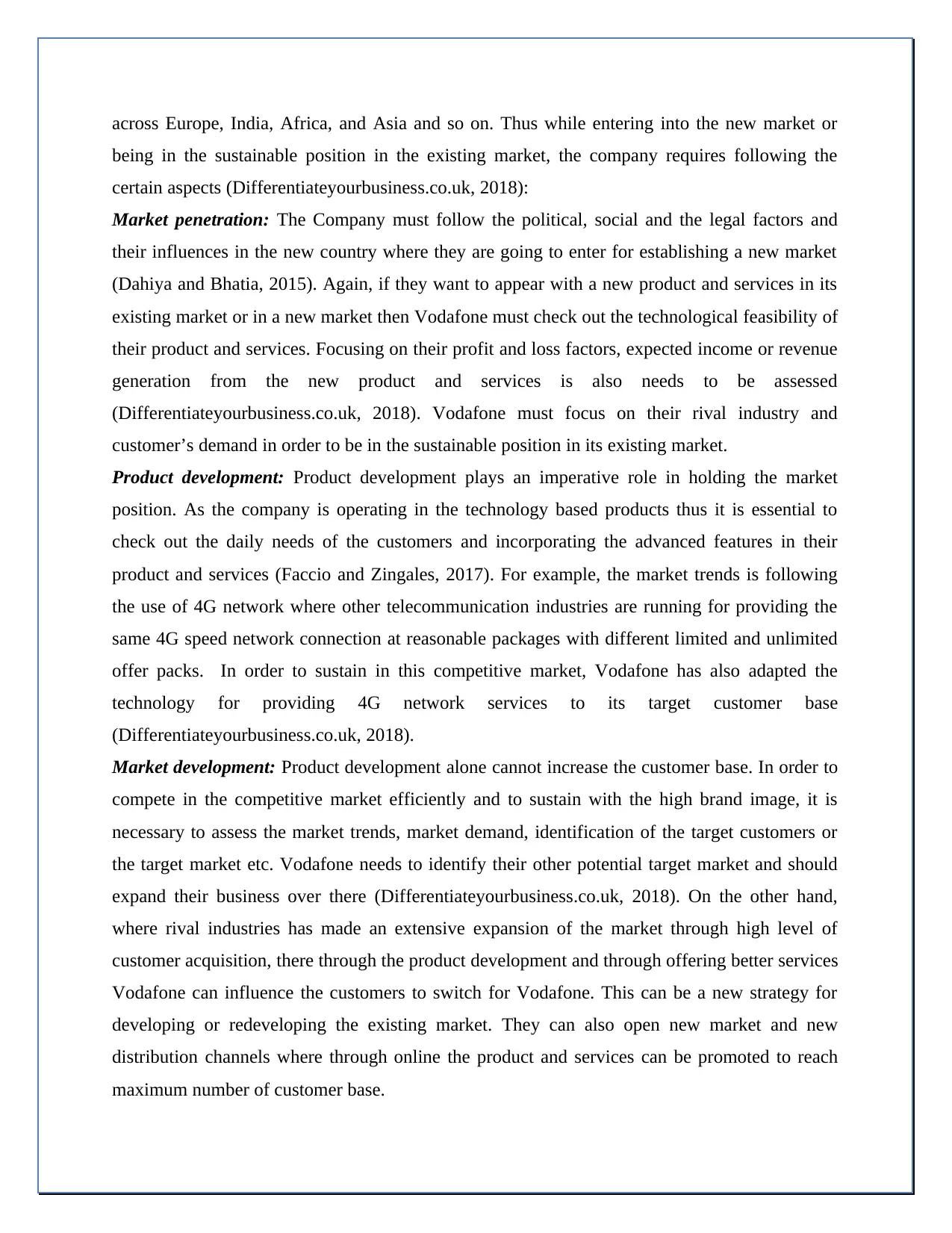
across Europe, India, Africa, and Asia and so on. Thus while entering into the new market or
being in the sustainable position in the existing market, the company requires following the
certain aspects (Differentiateyourbusiness.co.uk, 2018):
Market penetration: The Company must follow the political, social and the legal factors and
their influences in the new country where they are going to enter for establishing a new market
(Dahiya and Bhatia, 2015). Again, if they want to appear with a new product and services in its
existing market or in a new market then Vodafone must check out the technological feasibility of
their product and services. Focusing on their profit and loss factors, expected income or revenue
generation from the new product and services is also needs to be assessed
(Differentiateyourbusiness.co.uk, 2018). Vodafone must focus on their rival industry and
customer’s demand in order to be in the sustainable position in its existing market.
Product development: Product development plays an imperative role in holding the market
position. As the company is operating in the technology based products thus it is essential to
check out the daily needs of the customers and incorporating the advanced features in their
product and services (Faccio and Zingales, 2017). For example, the market trends is following
the use of 4G network where other telecommunication industries are running for providing the
same 4G speed network connection at reasonable packages with different limited and unlimited
offer packs. In order to sustain in this competitive market, Vodafone has also adapted the
technology for providing 4G network services to its target customer base
(Differentiateyourbusiness.co.uk, 2018).
Market development: Product development alone cannot increase the customer base. In order to
compete in the competitive market efficiently and to sustain with the high brand image, it is
necessary to assess the market trends, market demand, identification of the target customers or
the target market etc. Vodafone needs to identify their other potential target market and should
expand their business over there (Differentiateyourbusiness.co.uk, 2018). On the other hand,
where rival industries has made an extensive expansion of the market through high level of
customer acquisition, there through the product development and through offering better services
Vodafone can influence the customers to switch for Vodafone. This can be a new strategy for
developing or redeveloping the existing market. They can also open new market and new
distribution channels where through online the product and services can be promoted to reach
maximum number of customer base.
being in the sustainable position in the existing market, the company requires following the
certain aspects (Differentiateyourbusiness.co.uk, 2018):
Market penetration: The Company must follow the political, social and the legal factors and
their influences in the new country where they are going to enter for establishing a new market
(Dahiya and Bhatia, 2015). Again, if they want to appear with a new product and services in its
existing market or in a new market then Vodafone must check out the technological feasibility of
their product and services. Focusing on their profit and loss factors, expected income or revenue
generation from the new product and services is also needs to be assessed
(Differentiateyourbusiness.co.uk, 2018). Vodafone must focus on their rival industry and
customer’s demand in order to be in the sustainable position in its existing market.
Product development: Product development plays an imperative role in holding the market
position. As the company is operating in the technology based products thus it is essential to
check out the daily needs of the customers and incorporating the advanced features in their
product and services (Faccio and Zingales, 2017). For example, the market trends is following
the use of 4G network where other telecommunication industries are running for providing the
same 4G speed network connection at reasonable packages with different limited and unlimited
offer packs. In order to sustain in this competitive market, Vodafone has also adapted the
technology for providing 4G network services to its target customer base
(Differentiateyourbusiness.co.uk, 2018).
Market development: Product development alone cannot increase the customer base. In order to
compete in the competitive market efficiently and to sustain with the high brand image, it is
necessary to assess the market trends, market demand, identification of the target customers or
the target market etc. Vodafone needs to identify their other potential target market and should
expand their business over there (Differentiateyourbusiness.co.uk, 2018). On the other hand,
where rival industries has made an extensive expansion of the market through high level of
customer acquisition, there through the product development and through offering better services
Vodafone can influence the customers to switch for Vodafone. This can be a new strategy for
developing or redeveloping the existing market. They can also open new market and new
distribution channels where through online the product and services can be promoted to reach
maximum number of customer base.
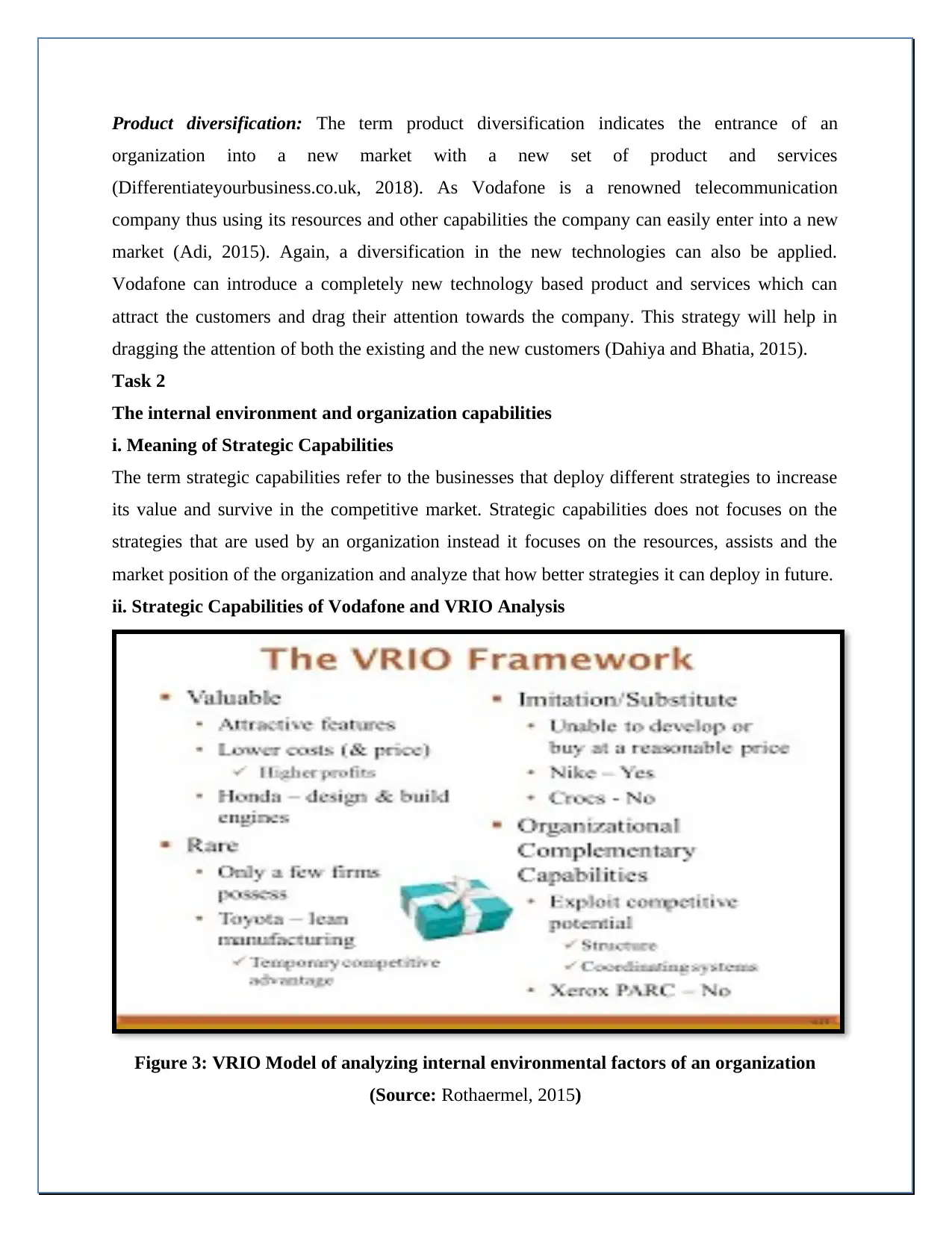
Product diversification: The term product diversification indicates the entrance of an
organization into a new market with a new set of product and services
(Differentiateyourbusiness.co.uk, 2018). As Vodafone is a renowned telecommunication
company thus using its resources and other capabilities the company can easily enter into a new
market (Adi, 2015). Again, a diversification in the new technologies can also be applied.
Vodafone can introduce a completely new technology based product and services which can
attract the customers and drag their attention towards the company. This strategy will help in
dragging the attention of both the existing and the new customers (Dahiya and Bhatia, 2015).
Task 2
The internal environment and organization capabilities
i. Meaning of Strategic Capabilities
The term strategic capabilities refer to the businesses that deploy different strategies to increase
its value and survive in the competitive market. Strategic capabilities does not focuses on the
strategies that are used by an organization instead it focuses on the resources, assists and the
market position of the organization and analyze that how better strategies it can deploy in future.
ii. Strategic Capabilities of Vodafone and VRIO Analysis
Figure 3: VRIO Model of analyzing internal environmental factors of an organization
(Source: Rothaermel, 2015)
organization into a new market with a new set of product and services
(Differentiateyourbusiness.co.uk, 2018). As Vodafone is a renowned telecommunication
company thus using its resources and other capabilities the company can easily enter into a new
market (Adi, 2015). Again, a diversification in the new technologies can also be applied.
Vodafone can introduce a completely new technology based product and services which can
attract the customers and drag their attention towards the company. This strategy will help in
dragging the attention of both the existing and the new customers (Dahiya and Bhatia, 2015).
Task 2
The internal environment and organization capabilities
i. Meaning of Strategic Capabilities
The term strategic capabilities refer to the businesses that deploy different strategies to increase
its value and survive in the competitive market. Strategic capabilities does not focuses on the
strategies that are used by an organization instead it focuses on the resources, assists and the
market position of the organization and analyze that how better strategies it can deploy in future.
ii. Strategic Capabilities of Vodafone and VRIO Analysis
Figure 3: VRIO Model of analyzing internal environmental factors of an organization
(Source: Rothaermel, 2015)
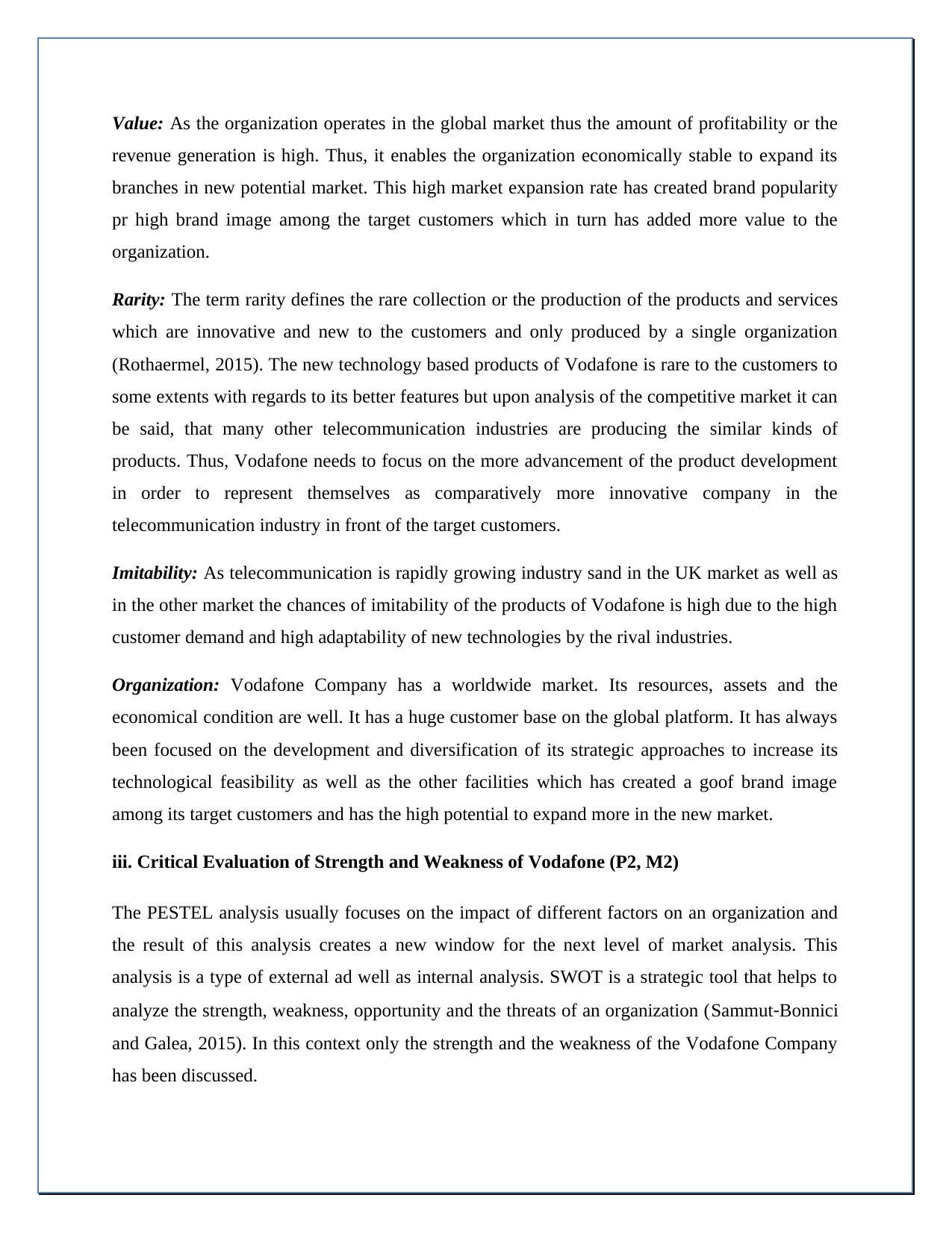
Value: As the organization operates in the global market thus the amount of profitability or the
revenue generation is high. Thus, it enables the organization economically stable to expand its
branches in new potential market. This high market expansion rate has created brand popularity
pr high brand image among the target customers which in turn has added more value to the
organization.
Rarity: The term rarity defines the rare collection or the production of the products and services
which are innovative and new to the customers and only produced by a single organization
(Rothaermel, 2015). The new technology based products of Vodafone is rare to the customers to
some extents with regards to its better features but upon analysis of the competitive market it can
be said, that many other telecommunication industries are producing the similar kinds of
products. Thus, Vodafone needs to focus on the more advancement of the product development
in order to represent themselves as comparatively more innovative company in the
telecommunication industry in front of the target customers.
Imitability: As telecommunication is rapidly growing industry sand in the UK market as well as
in the other market the chances of imitability of the products of Vodafone is high due to the high
customer demand and high adaptability of new technologies by the rival industries.
Organization: Vodafone Company has a worldwide market. Its resources, assets and the
economical condition are well. It has a huge customer base on the global platform. It has always
been focused on the development and diversification of its strategic approaches to increase its
technological feasibility as well as the other facilities which has created a goof brand image
among its target customers and has the high potential to expand more in the new market.
iii. Critical Evaluation of Strength and Weakness of Vodafone (P2, M2)
The PESTEL analysis usually focuses on the impact of different factors on an organization and
the result of this analysis creates a new window for the next level of market analysis. This
analysis is a type of external ad well as internal analysis. SWOT is a strategic tool that helps to
analyze the strength, weakness, opportunity and the threats of an organization (Sammut‐Bonnici
and Galea, 2015). In this context only the strength and the weakness of the Vodafone Company
has been discussed.
revenue generation is high. Thus, it enables the organization economically stable to expand its
branches in new potential market. This high market expansion rate has created brand popularity
pr high brand image among the target customers which in turn has added more value to the
organization.
Rarity: The term rarity defines the rare collection or the production of the products and services
which are innovative and new to the customers and only produced by a single organization
(Rothaermel, 2015). The new technology based products of Vodafone is rare to the customers to
some extents with regards to its better features but upon analysis of the competitive market it can
be said, that many other telecommunication industries are producing the similar kinds of
products. Thus, Vodafone needs to focus on the more advancement of the product development
in order to represent themselves as comparatively more innovative company in the
telecommunication industry in front of the target customers.
Imitability: As telecommunication is rapidly growing industry sand in the UK market as well as
in the other market the chances of imitability of the products of Vodafone is high due to the high
customer demand and high adaptability of new technologies by the rival industries.
Organization: Vodafone Company has a worldwide market. Its resources, assets and the
economical condition are well. It has a huge customer base on the global platform. It has always
been focused on the development and diversification of its strategic approaches to increase its
technological feasibility as well as the other facilities which has created a goof brand image
among its target customers and has the high potential to expand more in the new market.
iii. Critical Evaluation of Strength and Weakness of Vodafone (P2, M2)
The PESTEL analysis usually focuses on the impact of different factors on an organization and
the result of this analysis creates a new window for the next level of market analysis. This
analysis is a type of external ad well as internal analysis. SWOT is a strategic tool that helps to
analyze the strength, weakness, opportunity and the threats of an organization (Sammut‐Bonnici
and Galea, 2015). In this context only the strength and the weakness of the Vodafone Company
has been discussed.
Secure Best Marks with AI Grader
Need help grading? Try our AI Grader for instant feedback on your assignments.
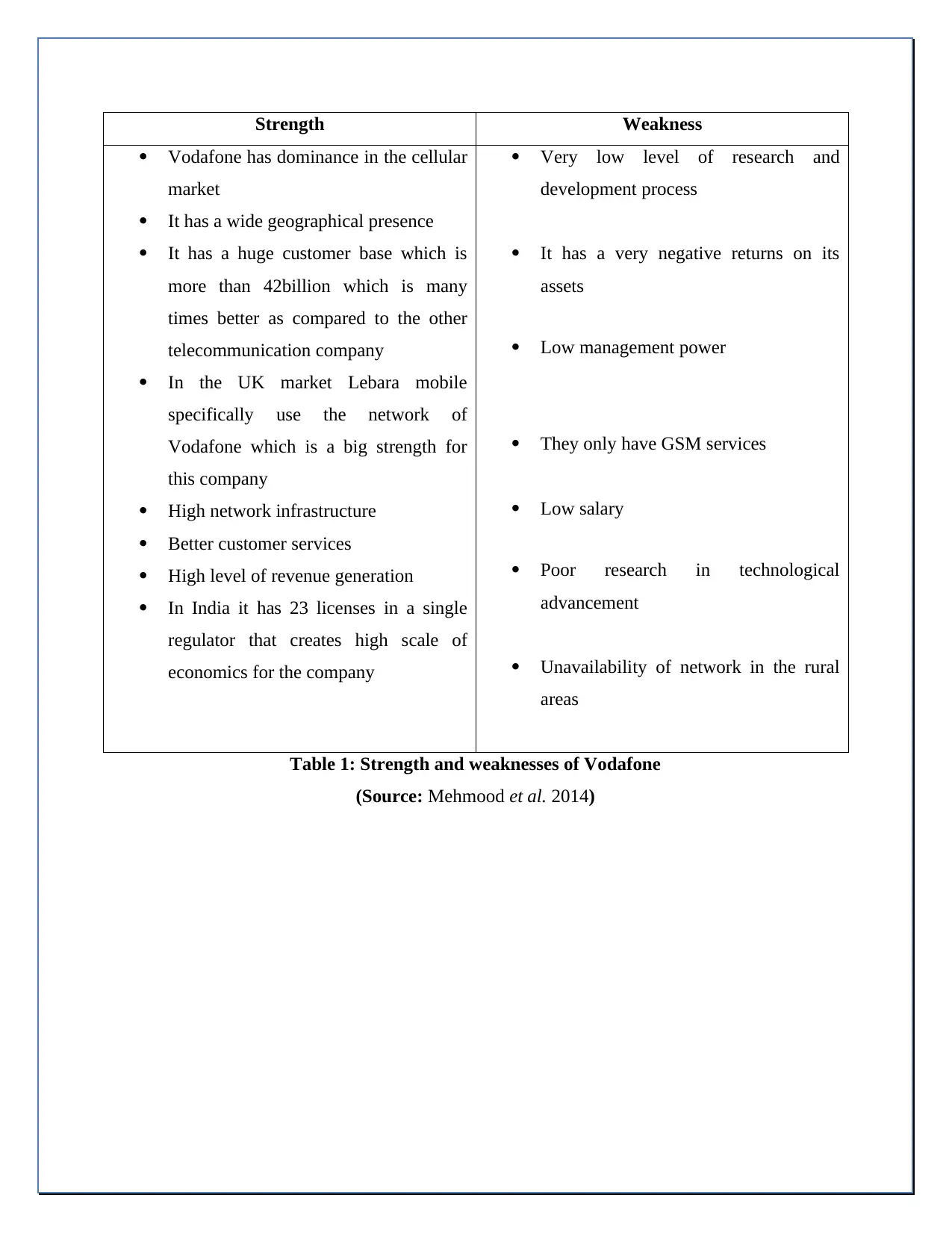
Strength Weakness
Vodafone has dominance in the cellular
market
It has a wide geographical presence
It has a huge customer base which is
more than 42billion which is many
times better as compared to the other
telecommunication company
In the UK market Lebara mobile
specifically use the network of
Vodafone which is a big strength for
this company
High network infrastructure
Better customer services
High level of revenue generation
In India it has 23 licenses in a single
regulator that creates high scale of
economics for the company
Very low level of research and
development process
It has a very negative returns on its
assets
Low management power
They only have GSM services
Low salary
Poor research in technological
advancement
Unavailability of network in the rural
areas
Table 1: Strength and weaknesses of Vodafone
(Source: Mehmood et al. 2014)
Vodafone has dominance in the cellular
market
It has a wide geographical presence
It has a huge customer base which is
more than 42billion which is many
times better as compared to the other
telecommunication company
In the UK market Lebara mobile
specifically use the network of
Vodafone which is a big strength for
this company
High network infrastructure
Better customer services
High level of revenue generation
In India it has 23 licenses in a single
regulator that creates high scale of
economics for the company
Very low level of research and
development process
It has a very negative returns on its
assets
Low management power
They only have GSM services
Low salary
Poor research in technological
advancement
Unavailability of network in the rural
areas
Table 1: Strength and weaknesses of Vodafone
(Source: Mehmood et al. 2014)
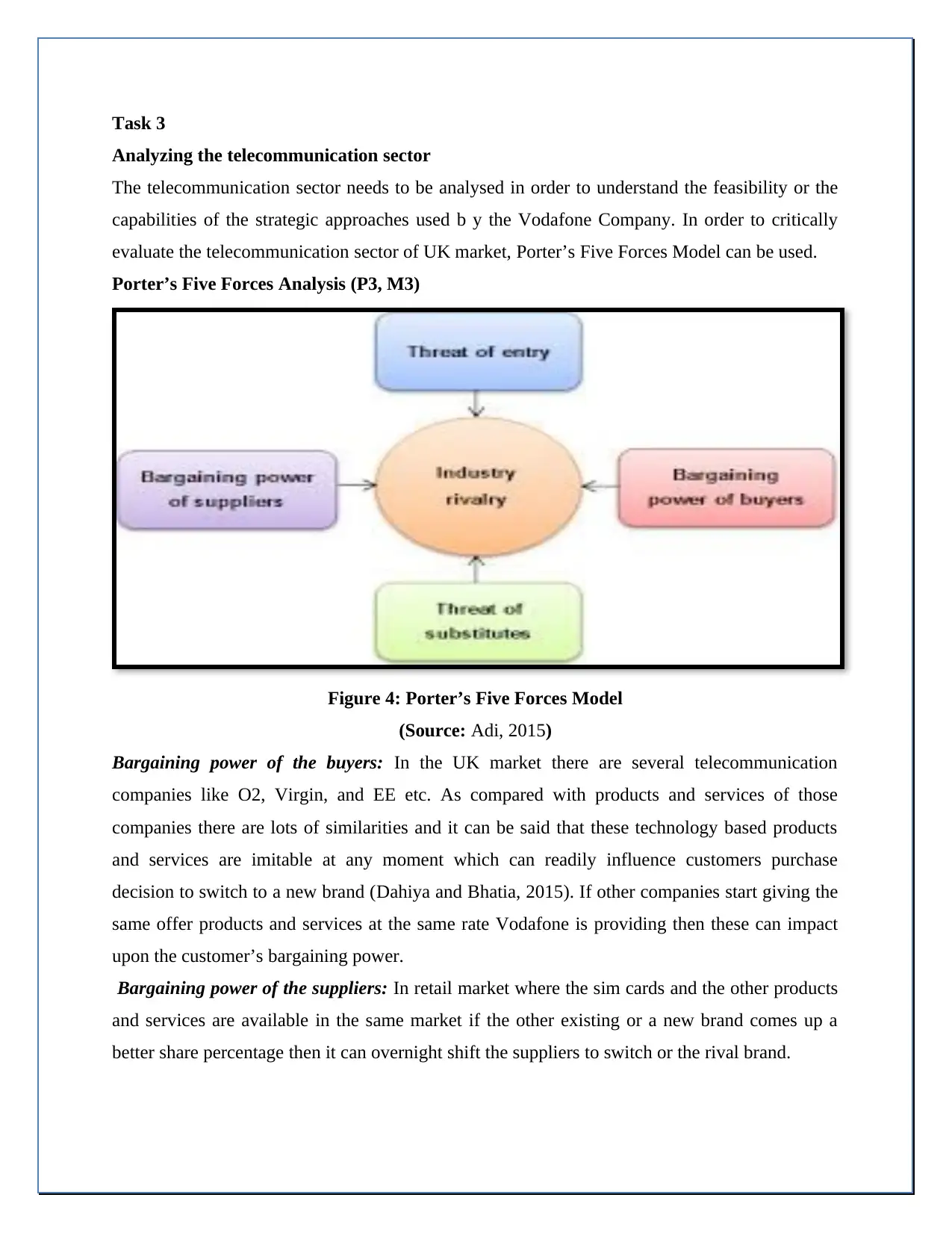
Task 3
Analyzing the telecommunication sector
The telecommunication sector needs to be analysed in order to understand the feasibility or the
capabilities of the strategic approaches used b y the Vodafone Company. In order to critically
evaluate the telecommunication sector of UK market, Porter’s Five Forces Model can be used.
Porter’s Five Forces Analysis (P3, M3)
Figure 4: Porter’s Five Forces Model
(Source: Adi, 2015)
Bargaining power of the buyers: In the UK market there are several telecommunication
companies like O2, Virgin, and EE etc. As compared with products and services of those
companies there are lots of similarities and it can be said that these technology based products
and services are imitable at any moment which can readily influence customers purchase
decision to switch to a new brand (Dahiya and Bhatia, 2015). If other companies start giving the
same offer products and services at the same rate Vodafone is providing then these can impact
upon the customer’s bargaining power.
Bargaining power of the suppliers: In retail market where the sim cards and the other products
and services are available in the same market if the other existing or a new brand comes up a
better share percentage then it can overnight shift the suppliers to switch or the rival brand.
Analyzing the telecommunication sector
The telecommunication sector needs to be analysed in order to understand the feasibility or the
capabilities of the strategic approaches used b y the Vodafone Company. In order to critically
evaluate the telecommunication sector of UK market, Porter’s Five Forces Model can be used.
Porter’s Five Forces Analysis (P3, M3)
Figure 4: Porter’s Five Forces Model
(Source: Adi, 2015)
Bargaining power of the buyers: In the UK market there are several telecommunication
companies like O2, Virgin, and EE etc. As compared with products and services of those
companies there are lots of similarities and it can be said that these technology based products
and services are imitable at any moment which can readily influence customers purchase
decision to switch to a new brand (Dahiya and Bhatia, 2015). If other companies start giving the
same offer products and services at the same rate Vodafone is providing then these can impact
upon the customer’s bargaining power.
Bargaining power of the suppliers: In retail market where the sim cards and the other products
and services are available in the same market if the other existing or a new brand comes up a
better share percentage then it can overnight shift the suppliers to switch or the rival brand.
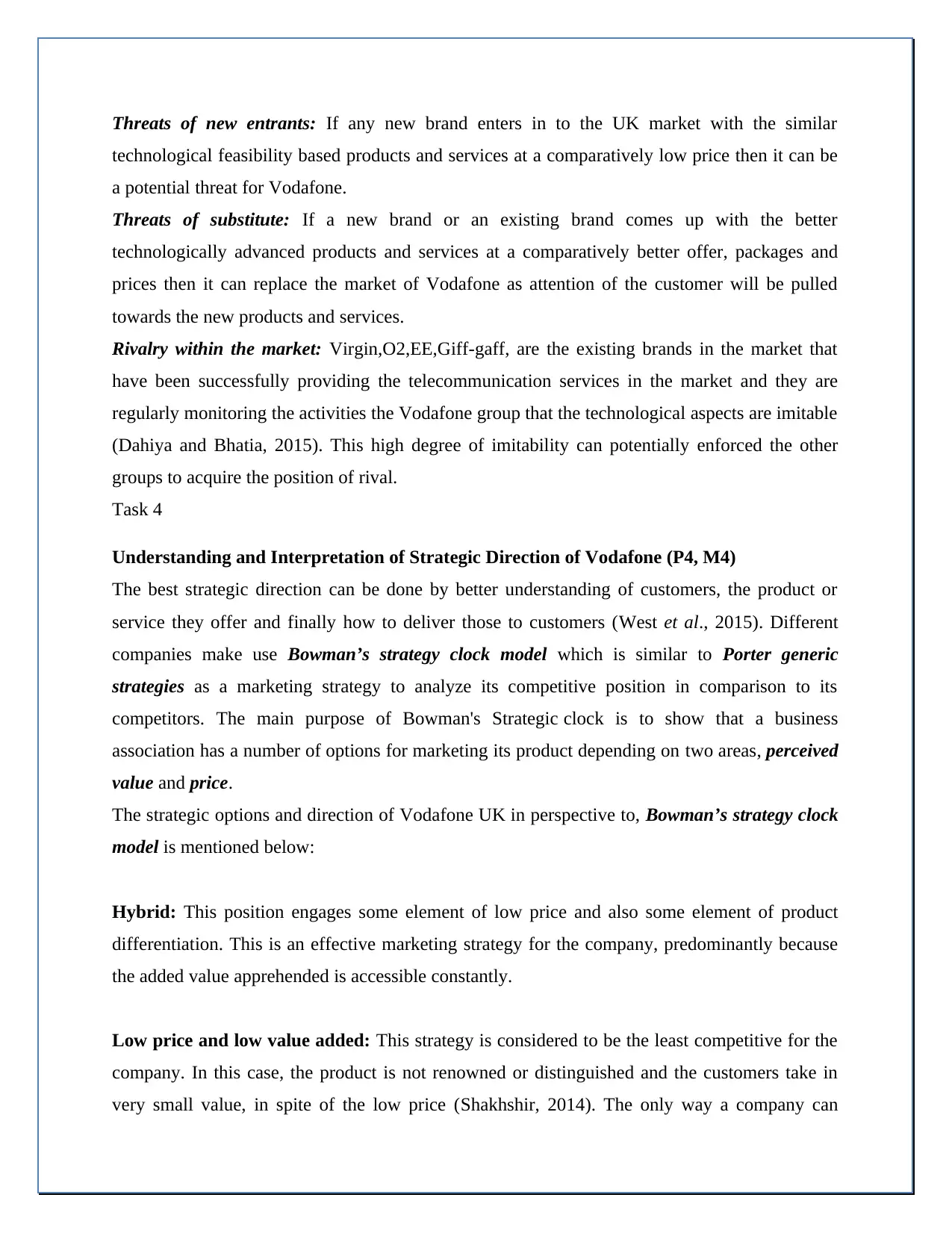
Threats of new entrants: If any new brand enters in to the UK market with the similar
technological feasibility based products and services at a comparatively low price then it can be
a potential threat for Vodafone.
Threats of substitute: If a new brand or an existing brand comes up with the better
technologically advanced products and services at a comparatively better offer, packages and
prices then it can replace the market of Vodafone as attention of the customer will be pulled
towards the new products and services.
Rivalry within the market: Virgin,O2,EE,Giff-gaff, are the existing brands in the market that
have been successfully providing the telecommunication services in the market and they are
regularly monitoring the activities the Vodafone group that the technological aspects are imitable
(Dahiya and Bhatia, 2015). This high degree of imitability can potentially enforced the other
groups to acquire the position of rival.
Task 4
Understanding and Interpretation of Strategic Direction of Vodafone (P4, M4)
The best strategic direction can be done by better understanding of customers, the product or
service they offer and finally how to deliver those to customers (West et al., 2015). Different
companies make use Bowman’s strategy clock model which is similar to Porter generic
strategies as a marketing strategy to analyze its competitive position in comparison to its
competitors. The main purpose of Bowman's Strategic clock is to show that a business
association has a number of options for marketing its product depending on two areas, perceived
value and price.
The strategic options and direction of Vodafone UK in perspective to, Bowman’s strategy clock
model is mentioned below:
Hybrid: This position engages some element of low price and also some element of product
differentiation. This is an effective marketing strategy for the company, predominantly because
the added value apprehended is accessible constantly.
Low price and low value added: This strategy is considered to be the least competitive for the
company. In this case, the product is not renowned or distinguished and the customers take in
very small value, in spite of the low price (Shakhshir, 2014). The only way a company can
technological feasibility based products and services at a comparatively low price then it can be
a potential threat for Vodafone.
Threats of substitute: If a new brand or an existing brand comes up with the better
technologically advanced products and services at a comparatively better offer, packages and
prices then it can replace the market of Vodafone as attention of the customer will be pulled
towards the new products and services.
Rivalry within the market: Virgin,O2,EE,Giff-gaff, are the existing brands in the market that
have been successfully providing the telecommunication services in the market and they are
regularly monitoring the activities the Vodafone group that the technological aspects are imitable
(Dahiya and Bhatia, 2015). This high degree of imitability can potentially enforced the other
groups to acquire the position of rival.
Task 4
Understanding and Interpretation of Strategic Direction of Vodafone (P4, M4)
The best strategic direction can be done by better understanding of customers, the product or
service they offer and finally how to deliver those to customers (West et al., 2015). Different
companies make use Bowman’s strategy clock model which is similar to Porter generic
strategies as a marketing strategy to analyze its competitive position in comparison to its
competitors. The main purpose of Bowman's Strategic clock is to show that a business
association has a number of options for marketing its product depending on two areas, perceived
value and price.
The strategic options and direction of Vodafone UK in perspective to, Bowman’s strategy clock
model is mentioned below:
Hybrid: This position engages some element of low price and also some element of product
differentiation. This is an effective marketing strategy for the company, predominantly because
the added value apprehended is accessible constantly.
Low price and low value added: This strategy is considered to be the least competitive for the
company. In this case, the product is not renowned or distinguished and the customers take in
very small value, in spite of the low price (Shakhshir, 2014). The only way a company can
Paraphrase This Document
Need a fresh take? Get an instant paraphrase of this document with our AI Paraphraser
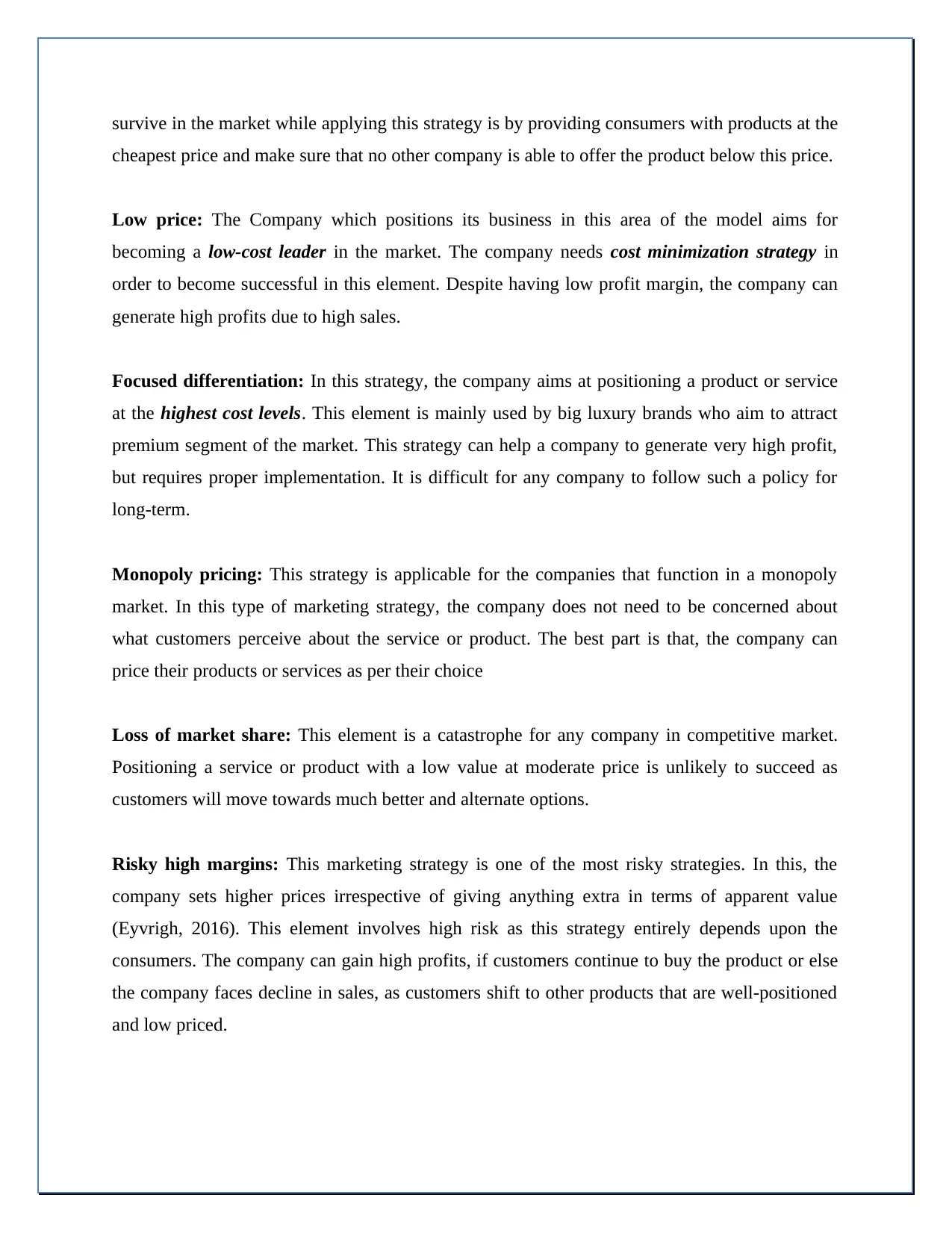
survive in the market while applying this strategy is by providing consumers with products at the
cheapest price and make sure that no other company is able to offer the product below this price.
Low price: The Company which positions its business in this area of the model aims for
becoming a low-cost leader in the market. The company needs cost minimization strategy in
order to become successful in this element. Despite having low profit margin, the company can
generate high profits due to high sales.
Focused differentiation: In this strategy, the company aims at positioning a product or service
at the highest cost levels. This element is mainly used by big luxury brands who aim to attract
premium segment of the market. This strategy can help a company to generate very high profit,
but requires proper implementation. It is difficult for any company to follow such a policy for
long-term.
Monopoly pricing: This strategy is applicable for the companies that function in a monopoly
market. In this type of marketing strategy, the company does not need to be concerned about
what customers perceive about the service or product. The best part is that, the company can
price their products or services as per their choice
Loss of market share: This element is a catastrophe for any company in competitive market.
Positioning a service or product with a low value at moderate price is unlikely to succeed as
customers will move towards much better and alternate options.
Risky high margins: This marketing strategy is one of the most risky strategies. In this, the
company sets higher prices irrespective of giving anything extra in terms of apparent value
(Eyvrigh, 2016). This element involves high risk as this strategy entirely depends upon the
consumers. The company can gain high profits, if customers continue to buy the product or else
the company faces decline in sales, as customers shift to other products that are well-positioned
and low priced.
cheapest price and make sure that no other company is able to offer the product below this price.
Low price: The Company which positions its business in this area of the model aims for
becoming a low-cost leader in the market. The company needs cost minimization strategy in
order to become successful in this element. Despite having low profit margin, the company can
generate high profits due to high sales.
Focused differentiation: In this strategy, the company aims at positioning a product or service
at the highest cost levels. This element is mainly used by big luxury brands who aim to attract
premium segment of the market. This strategy can help a company to generate very high profit,
but requires proper implementation. It is difficult for any company to follow such a policy for
long-term.
Monopoly pricing: This strategy is applicable for the companies that function in a monopoly
market. In this type of marketing strategy, the company does not need to be concerned about
what customers perceive about the service or product. The best part is that, the company can
price their products or services as per their choice
Loss of market share: This element is a catastrophe for any company in competitive market.
Positioning a service or product with a low value at moderate price is unlikely to succeed as
customers will move towards much better and alternate options.
Risky high margins: This marketing strategy is one of the most risky strategies. In this, the
company sets higher prices irrespective of giving anything extra in terms of apparent value
(Eyvrigh, 2016). This element involves high risk as this strategy entirely depends upon the
consumers. The company can gain high profits, if customers continue to buy the product or else
the company faces decline in sales, as customers shift to other products that are well-positioned
and low priced.
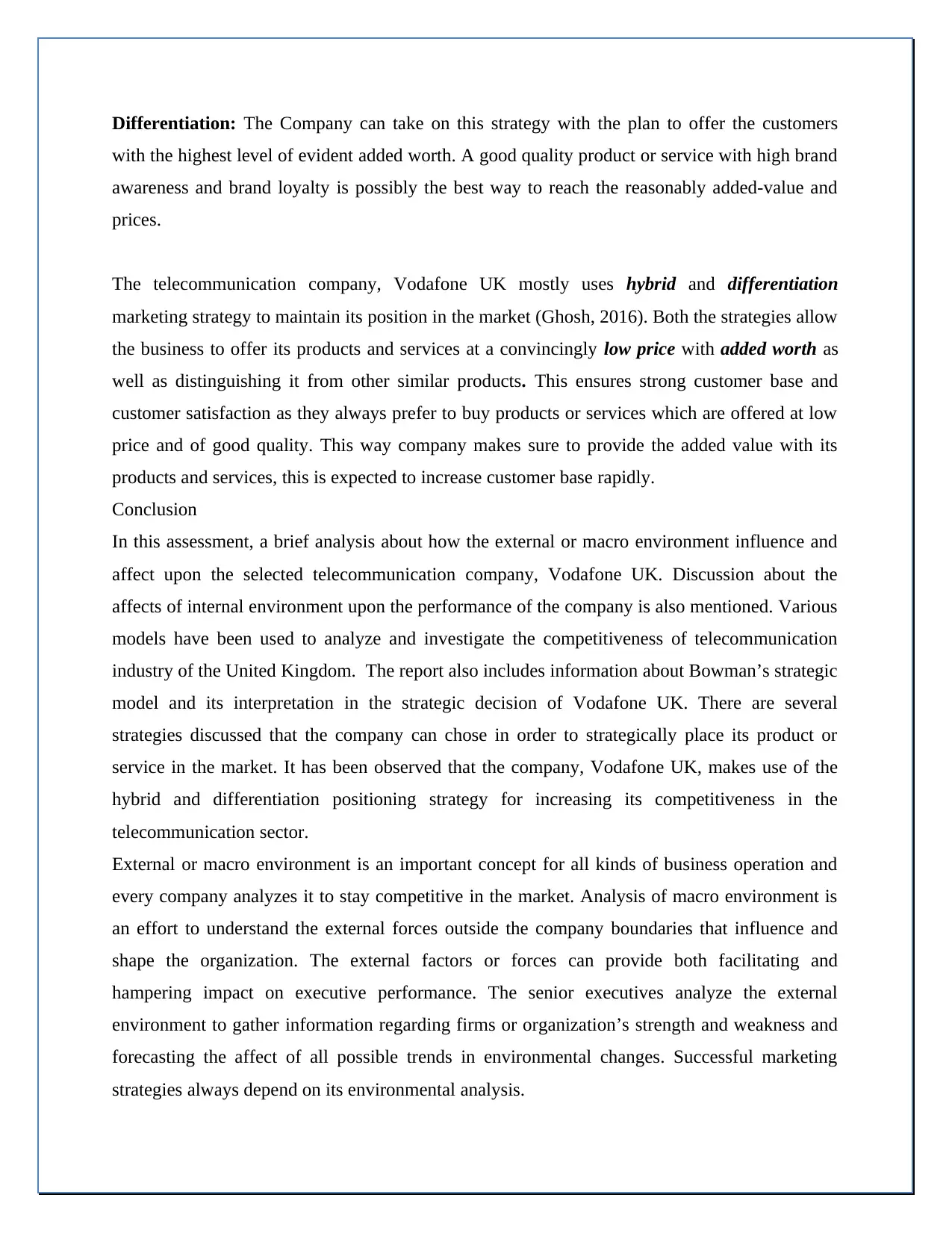
Differentiation: The Company can take on this strategy with the plan to offer the customers
with the highest level of evident added worth. A good quality product or service with high brand
awareness and brand loyalty is possibly the best way to reach the reasonably added-value and
prices.
The telecommunication company, Vodafone UK mostly uses hybrid and differentiation
marketing strategy to maintain its position in the market (Ghosh, 2016). Both the strategies allow
the business to offer its products and services at a convincingly low price with added worth as
well as distinguishing it from other similar products. This ensures strong customer base and
customer satisfaction as they always prefer to buy products or services which are offered at low
price and of good quality. This way company makes sure to provide the added value with its
products and services, this is expected to increase customer base rapidly.
Conclusion
In this assessment, a brief analysis about how the external or macro environment influence and
affect upon the selected telecommunication company, Vodafone UK. Discussion about the
affects of internal environment upon the performance of the company is also mentioned. Various
models have been used to analyze and investigate the competitiveness of telecommunication
industry of the United Kingdom. The report also includes information about Bowman’s strategic
model and its interpretation in the strategic decision of Vodafone UK. There are several
strategies discussed that the company can chose in order to strategically place its product or
service in the market. It has been observed that the company, Vodafone UK, makes use of the
hybrid and differentiation positioning strategy for increasing its competitiveness in the
telecommunication sector.
External or macro environment is an important concept for all kinds of business operation and
every company analyzes it to stay competitive in the market. Analysis of macro environment is
an effort to understand the external forces outside the company boundaries that influence and
shape the organization. The external factors or forces can provide both facilitating and
hampering impact on executive performance. The senior executives analyze the external
environment to gather information regarding firms or organization’s strength and weakness and
forecasting the affect of all possible trends in environmental changes. Successful marketing
strategies always depend on its environmental analysis.
with the highest level of evident added worth. A good quality product or service with high brand
awareness and brand loyalty is possibly the best way to reach the reasonably added-value and
prices.
The telecommunication company, Vodafone UK mostly uses hybrid and differentiation
marketing strategy to maintain its position in the market (Ghosh, 2016). Both the strategies allow
the business to offer its products and services at a convincingly low price with added worth as
well as distinguishing it from other similar products. This ensures strong customer base and
customer satisfaction as they always prefer to buy products or services which are offered at low
price and of good quality. This way company makes sure to provide the added value with its
products and services, this is expected to increase customer base rapidly.
Conclusion
In this assessment, a brief analysis about how the external or macro environment influence and
affect upon the selected telecommunication company, Vodafone UK. Discussion about the
affects of internal environment upon the performance of the company is also mentioned. Various
models have been used to analyze and investigate the competitiveness of telecommunication
industry of the United Kingdom. The report also includes information about Bowman’s strategic
model and its interpretation in the strategic decision of Vodafone UK. There are several
strategies discussed that the company can chose in order to strategically place its product or
service in the market. It has been observed that the company, Vodafone UK, makes use of the
hybrid and differentiation positioning strategy for increasing its competitiveness in the
telecommunication sector.
External or macro environment is an important concept for all kinds of business operation and
every company analyzes it to stay competitive in the market. Analysis of macro environment is
an effort to understand the external forces outside the company boundaries that influence and
shape the organization. The external factors or forces can provide both facilitating and
hampering impact on executive performance. The senior executives analyze the external
environment to gather information regarding firms or organization’s strength and weakness and
forecasting the affect of all possible trends in environmental changes. Successful marketing
strategies always depend on its environmental analysis.
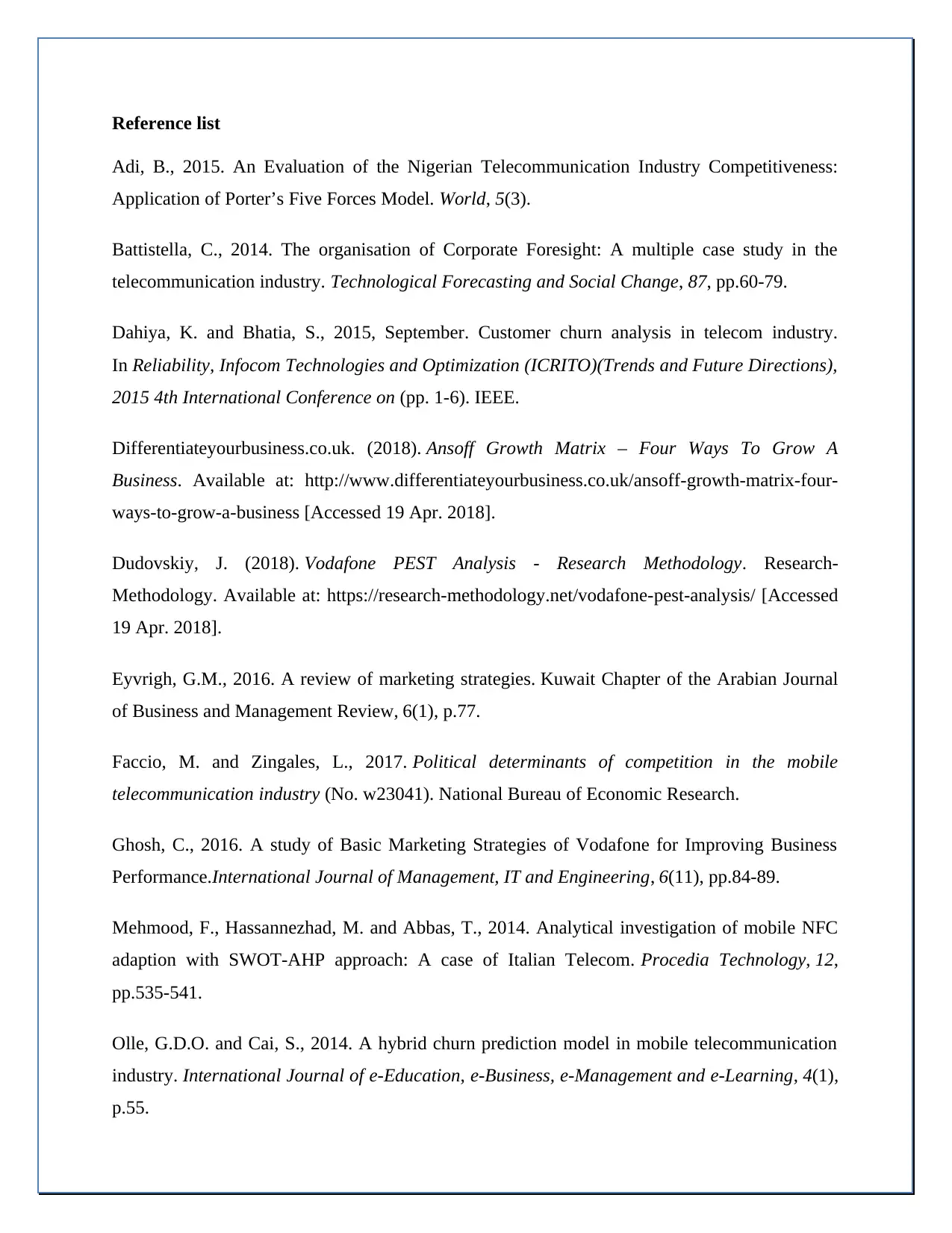
Reference list
Adi, B., 2015. An Evaluation of the Nigerian Telecommunication Industry Competitiveness:
Application of Porter’s Five Forces Model. World, 5(3).
Battistella, C., 2014. The organisation of Corporate Foresight: A multiple case study in the
telecommunication industry. Technological Forecasting and Social Change, 87, pp.60-79.
Dahiya, K. and Bhatia, S., 2015, September. Customer churn analysis in telecom industry.
In Reliability, Infocom Technologies and Optimization (ICRITO)(Trends and Future Directions),
2015 4th International Conference on (pp. 1-6). IEEE.
Differentiateyourbusiness.co.uk. (2018). Ansoff Growth Matrix – Four Ways To Grow A
Business. Available at: http://www.differentiateyourbusiness.co.uk/ansoff-growth-matrix-four-
ways-to-grow-a-business [Accessed 19 Apr. 2018].
Dudovskiy, J. (2018). Vodafone PEST Analysis - Research Methodology. Research-
Methodology. Available at: https://research-methodology.net/vodafone-pest-analysis/ [Accessed
19 Apr. 2018].
Eyvrigh, G.M., 2016. A review of marketing strategies. Kuwait Chapter of the Arabian Journal
of Business and Management Review, 6(1), p.77.
Faccio, M. and Zingales, L., 2017. Political determinants of competition in the mobile
telecommunication industry (No. w23041). National Bureau of Economic Research.
Ghosh, C., 2016. A study of Basic Marketing Strategies of Vodafone for Improving Business
Performance.International Journal of Management, IT and Engineering, 6(11), pp.84-89.
Mehmood, F., Hassannezhad, M. and Abbas, T., 2014. Analytical investigation of mobile NFC
adaption with SWOT-AHP approach: A case of Italian Telecom. Procedia Technology, 12,
pp.535-541.
Olle, G.D.O. and Cai, S., 2014. A hybrid churn prediction model in mobile telecommunication
industry. International Journal of e-Education, e-Business, e-Management and e-Learning, 4(1),
p.55.
Adi, B., 2015. An Evaluation of the Nigerian Telecommunication Industry Competitiveness:
Application of Porter’s Five Forces Model. World, 5(3).
Battistella, C., 2014. The organisation of Corporate Foresight: A multiple case study in the
telecommunication industry. Technological Forecasting and Social Change, 87, pp.60-79.
Dahiya, K. and Bhatia, S., 2015, September. Customer churn analysis in telecom industry.
In Reliability, Infocom Technologies and Optimization (ICRITO)(Trends and Future Directions),
2015 4th International Conference on (pp. 1-6). IEEE.
Differentiateyourbusiness.co.uk. (2018). Ansoff Growth Matrix – Four Ways To Grow A
Business. Available at: http://www.differentiateyourbusiness.co.uk/ansoff-growth-matrix-four-
ways-to-grow-a-business [Accessed 19 Apr. 2018].
Dudovskiy, J. (2018). Vodafone PEST Analysis - Research Methodology. Research-
Methodology. Available at: https://research-methodology.net/vodafone-pest-analysis/ [Accessed
19 Apr. 2018].
Eyvrigh, G.M., 2016. A review of marketing strategies. Kuwait Chapter of the Arabian Journal
of Business and Management Review, 6(1), p.77.
Faccio, M. and Zingales, L., 2017. Political determinants of competition in the mobile
telecommunication industry (No. w23041). National Bureau of Economic Research.
Ghosh, C., 2016. A study of Basic Marketing Strategies of Vodafone for Improving Business
Performance.International Journal of Management, IT and Engineering, 6(11), pp.84-89.
Mehmood, F., Hassannezhad, M. and Abbas, T., 2014. Analytical investigation of mobile NFC
adaption with SWOT-AHP approach: A case of Italian Telecom. Procedia Technology, 12,
pp.535-541.
Olle, G.D.O. and Cai, S., 2014. A hybrid churn prediction model in mobile telecommunication
industry. International Journal of e-Education, e-Business, e-Management and e-Learning, 4(1),
p.55.
Secure Best Marks with AI Grader
Need help grading? Try our AI Grader for instant feedback on your assignments.
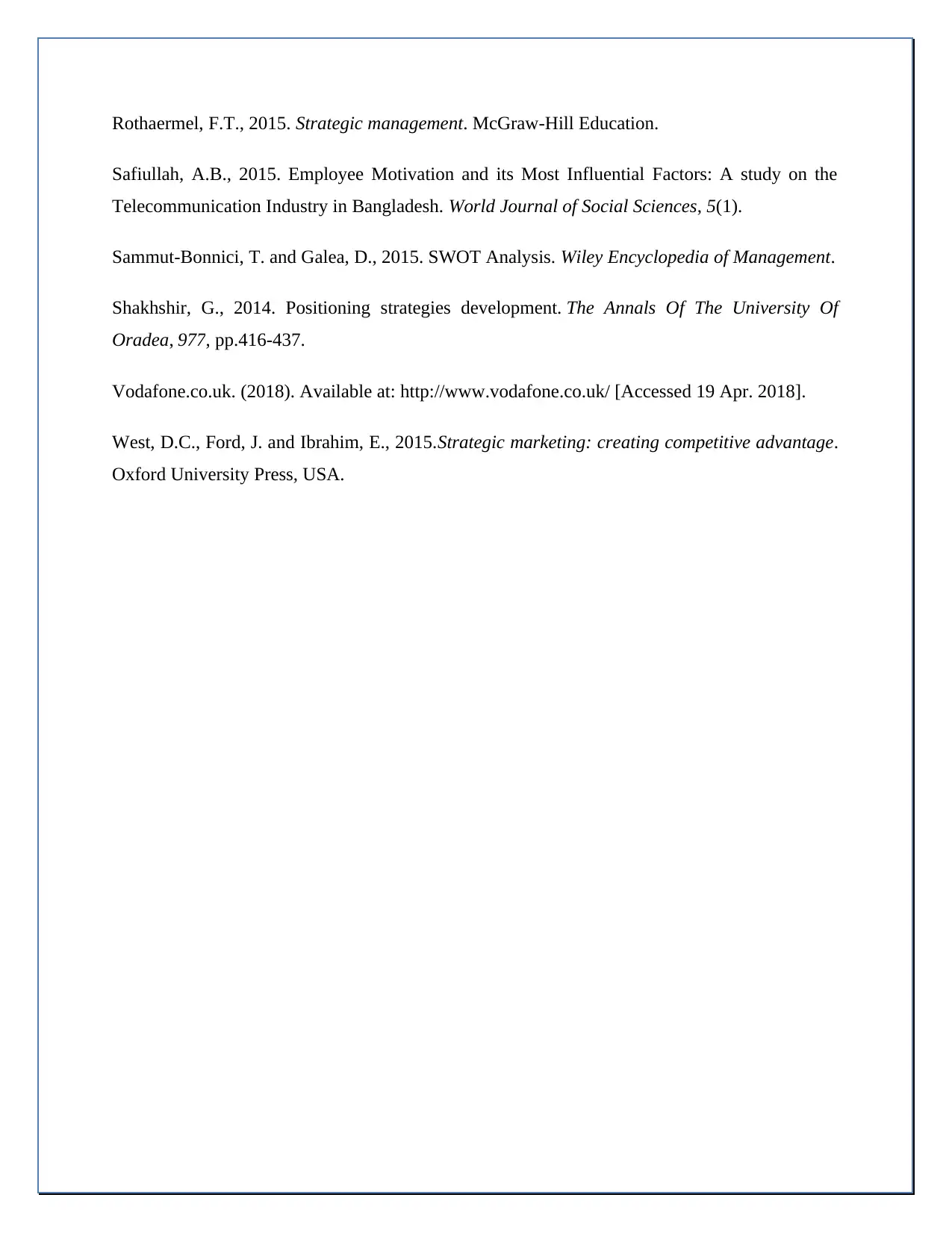
Rothaermel, F.T., 2015. Strategic management. McGraw-Hill Education.
Safiullah, A.B., 2015. Employee Motivation and its Most Influential Factors: A study on the
Telecommunication Industry in Bangladesh. World Journal of Social Sciences, 5(1).
Sammut‐Bonnici, T. and Galea, D., 2015. SWOT Analysis. Wiley Encyclopedia of Management.
Shakhshir, G., 2014. Positioning strategies development. The Annals Of The University Of
Oradea, 977, pp.416-437.
Vodafone.co.uk. (2018). Available at: http://www.vodafone.co.uk/ [Accessed 19 Apr. 2018].
West, D.C., Ford, J. and Ibrahim, E., 2015.Strategic marketing: creating competitive advantage.
Oxford University Press, USA.
Safiullah, A.B., 2015. Employee Motivation and its Most Influential Factors: A study on the
Telecommunication Industry in Bangladesh. World Journal of Social Sciences, 5(1).
Sammut‐Bonnici, T. and Galea, D., 2015. SWOT Analysis. Wiley Encyclopedia of Management.
Shakhshir, G., 2014. Positioning strategies development. The Annals Of The University Of
Oradea, 977, pp.416-437.
Vodafone.co.uk. (2018). Available at: http://www.vodafone.co.uk/ [Accessed 19 Apr. 2018].
West, D.C., Ford, J. and Ibrahim, E., 2015.Strategic marketing: creating competitive advantage.
Oxford University Press, USA.
1 out of 17
Related Documents
Your All-in-One AI-Powered Toolkit for Academic Success.
+13062052269
info@desklib.com
Available 24*7 on WhatsApp / Email
![[object Object]](/_next/static/media/star-bottom.7253800d.svg)
Unlock your academic potential
© 2024 | Zucol Services PVT LTD | All rights reserved.





